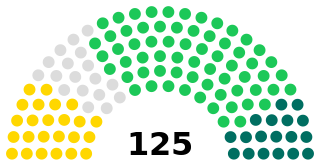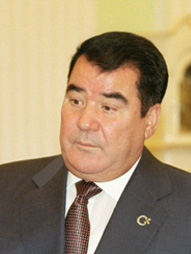
The history of Turkmenistan traditionally began with the arrival of Indo-European Iranian tribes around 2000 BC. Early tribes were nomadic or semi-nomadic due to the arid conditions of the region, preventing widespread adoption of agriculture. The steppe culture in Central Asia was an extension of a larger Eurasian series of horse cultures which spanned the entire spectrum of language families, including the Indo-Europeans and Turko-Mongol groups. Some of the known early Iranian tribes included the Massagatae, the Scythians/Sakas, and early Soghdians, who were most likely precursors of the Khwarezmians. Turkmenistan was a passing point for numerous migrations and invasions by tribes, which gravitated towards the settled regions of the south, including ancient Mesopotamia, Elam, and the Indus Valley civilization.

The politics of Turkmenistan nominally takes place in the framework of a presidential republic, whereby the President of Turkmenistan is nominally both head of state and head of government. However, as of 21 January 2023 a "national leader" was appointed who chairs an independent People's Council (viz.) with authority to amend the constitution, and who exercises supreme political authority. No true opposition parties are allowed; every registered political party supports the third and current President Serdar Berdimuhamedow. The country is frequently described as a totalitarian state.

Turkmenistan is a landlocked country in Central Asia bordered by Kazakhstan to the northwest, Uzbekistan to the north, east and northeast, Afghanistan to the southeast, Iran to the south and southwest and the Caspian Sea to the west. Ashgabat is the capital and largest city. It is one of the six independent Turkic states. With a population of 6.5 million, Turkmenistan is the 35th most-populous country in Asia and has the lowest population of the Central Asian republics while being one of the most sparsely populated nations on the Asian continent.

Turkmenistan elects on national level a head of state — the president — and a legislature. The elections in Turkmenistan since its split from the Soviet Union have been widely criticized for being neither free nor fair and attempting to give an appearance of legitimacy to what is in reality a dictatorship. Parties in Turkmenistan are the Democratic Party of Turkmenistan and the Party of Industrialists and Entrepreneurs. The president has a seven-year term, while the legislature has a five-year term.

The president of Turkmenistan, officially the president and chairman of the Cabinet of Ministers of Turkmenistan, is the head of state and head of government of Turkmenistan. The president is also the supreme commander in chief of the Armed Forces of Turkmenistan and heads the State Security Council.

The National Assembly, also transliterated as Milli Mejlis, is the legislative branch of government in Azerbaijan. The unicameral National Assembly has 125 deputies: previously 100 members were elected for five-year terms in single-seat constituencies and 25 were members elected by proportional representation; as of the latest election, however, all 125 deputies are returned from single-member constituencies.

The People's Council of Turkmenistan is Turkmenistan's independent "representative body" exerting supreme constitutional authority. It includes in its membership, but is not considered part of, the legislature. Among other things, it is empowered to amend the constitution. Its chairperson is appointed by the president and is designated the "National Leader". State media referred to the People's Council as the "supreme organ of government authority". From 2018 to 2023 it was the upper chamber of Turkmenistan's Parliament, the "National Council".

The Assembly is the unicameral legislature of Turkmenistan. Between March 2021 and 21 January 2023, it was the lower house of the National Council of Turkmenistan. It consists of 125 members, who are elected for five-year terms in single-seat constituencies.

Presidential elections were held in Turkmenistan on 11 February 2007, following the death of president-for-life Saparmurat Niyazov on 21 December 2006.
Parliamentary elections were held in Turkmenistan on 14 December 2008, with a second round held in one constituency on 28 December 2008 and a revote in one constituency on 8 February 2009. The number of assembly members was increased from 65 to 125 in constitutional reforms enacted on 26 September 2008. It was the first election since Turkmenistan's independence in which, theoretically, parties other than the Democratic Party of Turkmenistan are allowed to take part since the constitution no longer defined Turkmenistan as a one-party state. However, no legal opposition parties had been set up and the fact that the election took place in single-seat constituencies greatly diminished the opposition's chance of gaining parliamentary representation.

Saparmurat Atayevich Niyazov, also known as Türkmenbaşy, was a Turkmen politician who ruled Turkmenistan from 1985 until his death in 2006. He was first secretary of the Turkmen Communist Party from 1985 until 1991 and supported the 1991 Soviet coup attempt. He continued to rule Turkmenistan for 15 years after independence from the Soviet Union in 1991.

An independence referendum was held in the Turkmen SSR on 26 October 1991.

A referendum on extending President Saparmurat Niyazov's term until 2002 was held in Turkmenistan on 15 January 1994. Official results showed that the proposal was approved by 99.99% of voters, with a 100% turnout.

Presidential elections were held in Turkmenistan on 21 June 1992, the first since independence. The sole candidate was Saparmurat Niyazov, who had served as the first Secretary of the Central Committee of the Communist Party of the Turkmen SSR since 21 December 1985. Other candidates were not allowed to participate in the elections.
Parliamentary elections were held in Turkmenistan on 12 December 1999. All 50 seats were won by the Democratic Party of Turkmenistan, which remained the sole legal party.
Parliamentary elections were held in Turkmenistan on 19 December 2004, with a second round in seven constituencies on 9 January 2005. A total of 131 candidates contested the 50 seats, all of whom were members of the Democratic Party of Turkmenistan, the country's sole legal party. Voter turnout was reported to be 76.88%, although in Ashgabat the low turnout prompted election officials to take the ballot boxes to people's houses.

Parliamentary elections were held in Turkmenistan on 15 December 2013. Although they were the first multi-party elections in the country's history, both contesting parties claimed loyalty to President Gurbanguly Berdimuhamedow. The ruling Democratic Party emerged as the largest faction in the Assembly with 47 of the 125 seats, losing its parliamentary majority for the first time since independence. The elections were criticized by the OSCE, Amnesty International, and opposition groups such as the Turkmen Initiative for Human Rights. Farid Tukhbatulin of the Turkmen Initiative for Human Rights said that there was little difference between the two major parties, arguing that neither truly represented opposition groups.

The Women's Union of Turkmenistan is a mass women's organisation in Turkmenistan. For a long time, Women's Union was the only women organization permitted in the country. Advocating for women's rights, this organization appeared as a non-governmental organization, but in reality, Women's Union was closely linked and controlled by the government.

People's Council elections were held in Turkmenistan on 28 March 2021 to elect 48 of the 56 members of the People's Council or Halk Maslahaty. Another eight were appointed by the president on 14 April 2021.

The Magtymguly Youth Organisation of Turkmenistan is a registered social and political organization in Turkmenistan. It held seats in the Mejilis of Turkmenistan of the sixth convocation (2013–2018). Despite this organization having the appearance of a non-governmental organization, in reality, Magtymguly Youth Organisation was closely linked and controlled by the government.









